Evaluating Daily Water Stress Index (DWSI) Using Thermal Imaging of Neem Tree Canopies under Bare Soil and Mulching Conditions
Abstract
:1. Introduction
2. Materials and Methods
2.1. Characterization of the Study Area
2.2. Image Acquisition and Analysis
2.3. Water Stress Indicator
2.4. Statistical and Geostatistical Analysis
3. Results
3.1. Changes in Soil Moisture and Climatic Conditions
3.2. Daily Water Stress Index
3.3. Relationships between Thermal Indices and Meteorological Parameters
3.4. Plant Canopy Status Mapping
4. Discussion
5. Conclusions
Author Contributions
Funding
Data Availability Statement
Acknowledgments
Conflicts of Interest
References
- da Silva, É.S.; Cruz, J.D.; Resende, J.J.; Campos, N.N.; Pinheiro, T.A. Alternative Control of Insects of Agricultural Importance Using Plant Extracts of Azadirachta Indica (Nim), in Feira De Santana, Bahia, Brazil. Braz. J. Dev. 2021, 7, 6579–6586. [Google Scholar] [CrossRef]
- de Brito, W.A.; Siquieroli, A.C.S.; Andaló, V.; Duarte, J.G.; de Sousa, R.M.F.; Felisbino, J.K.R.P.; da Silva, G.C. Botanical insecticide formulation with neem oil and D-limonene for coffee borer control. Pesqui. Agropecuária Bras. 2021, 56, e02000. [Google Scholar] [CrossRef]
- Albiero, B.; Freiberger, G.; Moraes, R.P.; Vanin, A.B. Potencial inseticida dos óleos essenciais de endro (anethum graveolens) e de nim (azadirachta indica) no controle de sitophilus zeamais. Braz. J. Dev. 2019, 5, 21443–21448. [Google Scholar] [CrossRef]
- de Lima, C.A.; Montenegro, A.A.d.A.; de Lima, J.L.M.P.; Almeida, T.A.B.; Dos Santos, J.C.N. Use of alternative soil covers for the control of soil loss in semiarid regions. Eng. Sanit. e Ambient. 2020, 25, 531–542. [Google Scholar] [CrossRef]
- Inocêncio, T.d.M.; Ribeiro Neto, A.; Oertel, M.; Meza, F.J.; Scott, C.A. Linking drought propagation with episodes of climate-Induced water insecurity in Pernambuco state—Northeast Brazil. J. Arid Environ. 2021, 193, 104593. [Google Scholar] [CrossRef]
- Nogueira, D.B.; da Silva, A.O.; Giroldo, A.B.; da Silva, A.P.N.; Costa, B.R.S. Dry spells in a semiarid region of Brazil and their influence on maize productivity. J. Arid Environ. 2023, 209, 104892. [Google Scholar] [CrossRef]
- Carvalho, A.A.; Abelardo, A.A.; da Silva, H.P.; Lopes, I.; de Morais, J.E.F.; da Silva, T.G.F. Trends of rainfall and temperature in Northeast Brazil. Rev. Bras. Eng. Agric. e Ambient. 2020, 24, 15–23. [Google Scholar] [CrossRef]
- Almeida, T.A.B.; Montenegro, A.A.d.A.; Mackay, R.; Montenegro, S.M.G.L.; Coelho, V.H.R.; de Carvalho, A.A.; da Silva, T.G.F. Hydrogeological trends in an alluvial valley in the Brazilian semiarid: Impacts of observed climate variables change and exploitation on groundwater availability and salinity. J. Hydrol. Reg. Stud. 2024, 53, 101784. [Google Scholar] [CrossRef]
- Oroud, I.M.; Balling, R.C. The utility of combining optical and thermal images in monitoring agricultural drought in semiarid mediterranean environments. J. Arid. Environ. 2021, 189, 104499. [Google Scholar] [CrossRef]
- Bo, L.; Guan, H.; Mao, X. Diagnosing crop water status based on canopy temperature as a function of film mulching and deficit irrigation. Field Crops Res. 2023, 304, 109154. [Google Scholar] [CrossRef]
- Li, R.; Chai, S.; Chai, Y.; Li, Y.; Lan, X.; Ma, J.; Cheng, H.; Chang, L. Mulching optimizes water consumption characteristics and improves crop water productivity on the semiarid Loess Plateau of China. Agric. Water Manag. 2021, 254, 106965. [Google Scholar] [CrossRef]
- Montenegro, A.A.A.; Almeida, T.A.B.; de Lima, C.A.; Abrantes, J.R.C.B.; de Lima, J.L.M.P. Evaluating mulch cover with coir dust and cover crop with Palma cactus as soil and water conservation techniques for semiarid environments: Laboratory soil flume study under simulated rainfall. Hydrology 2020, 7, 61. [Google Scholar] [CrossRef]
- Bazrgar, G.; Nabavi Kalat, S.M.; Khorasani, S.K.; Ghasemi, M.; Kelidari, A. Effect of deficit irrigation on physiological, biochemical, and yield characteristics in three baby corn cultivars (Zea mays L.). Heliyon 2023, 9, e15477. [Google Scholar] [CrossRef] [PubMed]
- Pineda, M.; Barón, M.; Pérez-Bueno, M.L. Thermal imaging for plant stress detection and phenotyping. Remote Sens. 2021, 13, 68. [Google Scholar] [CrossRef]
- Luan, Y.; Xu, J.; Lv, Y.; Liu, X.; Wang, H.; Liu, S. Improving the performance in crop water deficit diagnosis with canopy temperature spatial distribution information measured by thermal imaging. Agric. Water Manag. 2020, 246, 106699. [Google Scholar] [CrossRef]
- Ihuoma, S.O.; Madramootoo, C.A. Recent advances in crop water stress detection. In Computers and Electronics in Agriculture; Elsevier B.V.: Amsterdam, The Netherlands, 2017; Volume 141, pp. 267–275. [Google Scholar] [CrossRef]
- Debangshi, U.; Sadhukhan, A. Crop water stress monitoring through precision technologies: A review. Pharma Innov. 2023, 12, 803–808. [Google Scholar] [CrossRef]
- Shanmugapriya, P.; Rathika, S.; Ramesh, T.; Janaki, P. Applications of Remote Sensing in Agriculture—A Review. Int. J. Curr. Microbiol. Appl. Sci. 2019, 8, 2270–2283. [Google Scholar] [CrossRef]
- Sishodia, R.P.; Ray, R.L.; Singh, S.K. Applications of remote sensing in precision agriculture: A review. Remote Sens. 2020, 12, 3136. [Google Scholar] [CrossRef]
- Singh, V.; Sharma, N.; Singh, S. A review of imaging techniques for plant disease detection. Artif. Intell. Agric. 2020, 4, 229–242. [Google Scholar] [CrossRef]
- Menegassi, L.C.; Benassi, V.C.; Trevisan, L.R.; Rossi, F.; Gomes, T.M. Thermal imaging for stress assessment in rice cultivation drip-irrigated with saline water. Eng. Agric. 2022, 42, e20220043. [Google Scholar] [CrossRef]
- Liu, L.; Gao, X.; Ren, C.; Cheng, X.; Zhou, Y.; Huang, H.; Zhang, J.; Ba, Y. Applicability of the crop water stress index based on canopy–air temperature differences for monitoring water status in a cork oak plantation, northern China. Agric. For. Meteorol. 2022, 327, 109226. [Google Scholar] [CrossRef]
- Feiziasl, V.; Jafarzadeh, J.; Sadeghzadeh, B.; Mousavi Shalmani, M.A. Water deficit index to evaluate water stress status and drought tolerance of rainfed barley genotypes in cold semiarid area of Iran. Agric. Water Manag. 2021, 262, 107395. [Google Scholar] [CrossRef]
- Brunini, R.G.; Turco, J.E.P. Water stress indices for the sugarcane crop on different irrigated surfaces|Índices de estresse hídrico para a cultura de cana-de-açúcar em diferentes superfícies irrigadas. Rev. Bras. Eng. Agric. e Ambient. 2016, 20, 925–929. [Google Scholar] [CrossRef]
- Huo, H.; Li, Z.-L.; Xing, Z. Temperature/emissivity separation using hyperspectral thermal infrared imagery and its potential for detecting the water content of plants. Int. J. Remote Sens. 2018, 40, 1672–1692. [Google Scholar] [CrossRef]
- Valín, M.I.; Araújo-Paredes, C.A.; Rodrigues, A.S.; Alonso, J.; Mendes, S. Utilização de técnicas de termografia para a avaliação do estado hídrico da vitis vinífera cv Loureiro. In Proceedings of the X Congreso Ibérico de Agroingeniería, Huesca, Spain, 3–6 September 2019; pp. 899–905. [Google Scholar] [CrossRef]
- Liu, M.; Guan, H.; Ma, X.; Yu, S.; Liu, G. Recognition method of thermal infrared images of plant canopies based on the characteristic registration of heterogeneous images. Comput. Electron. Agric. 2020, 177, 105678. [Google Scholar] [CrossRef]
- Silva, A.d.N.; Ramos, M.L.G.; Ribeiro Junior, W.Q.; da Silva, P.C.; Soares, G.F.; Casari, R.A.d.C.N.; de Sousa, C.A.F.; de Lima, C.A.; Santana, C.C.; Silva, A.M.M.; et al. Use of Thermography to Evaluate Alternative Crops for Off-Season in the Cerrado Region. Plants 2023, 12, 2081. [Google Scholar] [CrossRef]
- Savvides, A.M.; Velez-Ramirez, A.I.; Fotopoulos, V. Challenging the water stress index concept: Thermographic assessment of Arabidopsis transpiration. Physiol. Plant. 2022, 174, e13762. [Google Scholar] [CrossRef] [PubMed]
- Tian, H.; Wang, T.; Liu, Y.; Qiao, X.; Li, Y. Computer vision technology in agricultural automation—A review. Inf. Process. Agric. 2020, 7, 1–19. [Google Scholar] [CrossRef]
- da Silva, M.V.; Pandorfi, H.; de Almeida, G.L.P.; da Silva, R.A.B.; Morales, K.R.M.; Guiselini, C.; Santana, T.C.; de Cangela, G.L.C.; Filho, J.A.D.B.; Moraes, A.S.; et al. Spatial modeling via geostatistics and infrared thermography of the skin temperature of dairy cows in a compost barn system in the Brazilian semiarid region. Smart Agric. Technol. 2023, 3, 100078. [Google Scholar] [CrossRef]
- Santana, T.C.; Guiselini, C.; Montenegro, A.A.d.A.; Pandorfi, H.; da Silva, R.A.B.; da Silva e Silva, R.; Batista, P.H.D.; Cavalcanti, S.D.L.; Gomes, N.F.; da Silva, M.V.; et al. Green roofs are effective in cooling and mitigating urban heat islands to improve human thermal comfort. Model. Earth Syst. Environ. 2023, 9, 3985–3998. [Google Scholar] [CrossRef]
- Kimwatu, D.M.; Mundia, C.N.; Makokha, G.O. Monitoring environmental water stress in the Upper Ewaso Ngiro river basin, Kenya. J. Arid. Environ. 2021, 191, 104533. [Google Scholar] [CrossRef]
- Landim, P.M.B. Análise Estatística de Dados Geológicos, 2nd ed.; Edunesp: Rio Claro, Brazil, 2003; ISBN 9788571395046. [Google Scholar]
- de Andrade, M.D.; Delgado, R.C.; da Costa de Menezes, S.J.M.; de Ávila Rodrigues, R.; Teodoro, P.E.; da Silva Junior, C.A.; Pereira, M.G. Evaluation of the MOD11A2 product for canopy temperature monitoring in the Brazilian Atlantic Forest. Environ. Monit. Assess. 2021, 193, 45. [Google Scholar] [CrossRef]
- Araújo-Paredes, C.; Portela, F.; Mendes, S.; Valín, M.I. Using Aerial Thermal Imagery to Evaluate Water Status in Vitis vinifera cv. Loureiro. Sensors 2022, 22, 8056. [Google Scholar] [CrossRef] [PubMed]
- Allen, R.G.; Pereira, L.S.; Raes, D.; Smith, M. Crop evapotranspiration—Guidelines for computing crop water requirements. In FAO Irrigation and Drainage Paper 56, 1st ed.; FAO: Rome, Italy, 1998; pp. 1–297. [Google Scholar]
- Thornthwaite, C.W.; Mather, J.R. The Water Balance; Drexel Institute of Technology—Laboratory of Climatology, Publications in Climatology: Centerton, AR, USA, 1955; 104p. [Google Scholar]
- Jackson, R.D.; Reginato, R.J.; Idso, S.B. Wheat canopy temperature: A practical tool for evaluating water requirements. Water Resour. Res. 1977, 13, 651–656. [Google Scholar] [CrossRef]
- Warrick, A.W.; Nielsen, D.R. Spatial variability of soil physical properties in the field. In Applications of Soil Physics; Hillel, D., Ed.; Cap. 2; Academic Press: New York, NY, USA, 1980; pp. 319–344. [Google Scholar]
- Ziegel, E.R.; Deutsch, C.V.; Journel, A.G. Geostatistical Software Library and User’s Guide, 2nd ed.; Oxford University Press: New York, NY, USA, 1998; 369p. [Google Scholar]
- Cambardella, C.A.; Moorman, T.B.; Novak, J.M.; Parkin, T.B.; Karlen, D.L.; Turco, R.F.; Konopka, A.E. Field-Scale Variability of Soil Properties in Central Iowa Soils. Soil Sci. Soc. Am. J. 1994, 58, 1501–1511. [Google Scholar] [CrossRef]
- Webster, R.; Oliver, M. Geostatistics for Environmental Scientists, 2nd ed.; Wiley: Chichester, UK, 2007. [Google Scholar]
- Sousa, L.B.; de Assunção Montenegro, A.A.; da Silva, M.V.; Almeida, T.A.B.; de Carvalho, A.A.; da Silva, T.G.F.; de Lima, J.L.M.P. Spatiotemporal Analysis of Rainfall and Droughts in a Semiarid Basin of Brazil: Land Use and Land Cover Dynamics. Remote Sens. 2023, 15, 2550. [Google Scholar] [CrossRef]
- Golden Software. Surfer for Windows Version 9.0; Golden Software: Golden, CO, USA, 2010; 66p. [Google Scholar]
- Hewlett, J.D. Principles of Forest Hydrology; The University of Georgia Press: Athens, GA, USA, 1982. [Google Scholar]
- Montenegro, A.A.A.; Montenegro, S.M.G.L. Variabilidade espacial de classes de textura, salinidade e condutividade hidráulica de solos em planície aluvial. Rev. Bras. Eng. Agrícola e Ambient. 2006, 10, 30–37. [Google Scholar] [CrossRef]
- King, B.A.; Shellie, K.C. A crop water stress index based internet of things decision support system for precision irrigation of wine grape. Smart Agric. Technol. 2023, 4, 100202. [Google Scholar] [CrossRef]
- Miri, A.; Webb, N. Characterizing the spatial variations of wind velocity and turbulence intensity around a single Tamarix tree. Geomorphology 2022, 414, 108382. [Google Scholar] [CrossRef]
- de Lima, J.L.M.P.; da Silva, J.R.L.; Montenegro, A.A.A.; Silva, V.P.; Abrantes, J.R.C.B. The effect of vegetal mulching on soil surface temperature in semiarid Brazil. Bodenkultur 2020, 71, 185–195. [Google Scholar] [CrossRef]
- Akhtar, K.; Wang, W.; Khan, A.; Ren, G.; Afridi, M.Z.; Feng, Y.; Yang, G. Wheat straw mulching offset soil moisture deficient for improving physiological and growth performance of summer sown soybean. Agric. Water Manag. 2019, 211, 16–25. [Google Scholar] [CrossRef]
- Lopes, I.; Montenegro, A.A.A.; de Lima, J.L.M.P. Performance of conservation techniques for semiarid environments: Field observations with caatinga, Mulch, and Cactus Forage Palma. Water 2019, 11, 792. [Google Scholar] [CrossRef]
- Galindo, A.; Rodríguez, P.; Mellisho, C.D.; Torrecillas, E.; Moriana, A.; Cruz, Z.N.; Conejero, W.; Moreno, F.; Torrecillas, A. Assessment of discretely measured indicators and maximum daily trunk shrinkage for detecting water stress in pomegranate trees. Agric. For. Meteorol. 2013, 180, 58–65. [Google Scholar] [CrossRef]
- Rico-Fernández, M.P.; Rios-Cabrera, R.; Castelán, M.; Guerrero-Reyes, H.I.; Juarez-Maldonado, A. A contextualized approach for segmentation of foliage in different crop species. Comput. Electron. Agric. 2019, 156, 378–386. [Google Scholar] [CrossRef]
- Camoglu, G.; Demirel, K.; Kahriman, F.; Akcal, A.; Nar, H. Plant-based monitoring techniques to detect yield and physiological responses in water-stressed pepper. Agric. Water Manag. 2024, 291, 108628. [Google Scholar] [CrossRef]
- De Paulo, R.L.; Garcia, A.P.; Umezu, C.K.; Camargo, A.P.D.; Soares, F.T.; Albiero, D. Water Stress Index Detection Using a Low-Cost Infrared Sensor and Excess Green Image Processing. Sensors 2023, 23, 1318. [Google Scholar] [CrossRef]
- Bai, T.; Tahmasebi, P. Sequential Gaussian Simulation for Geosystems Modeling: A Machine Learning Approach. Geosci. Front. 2022, 13, 101258. [Google Scholar] [CrossRef]

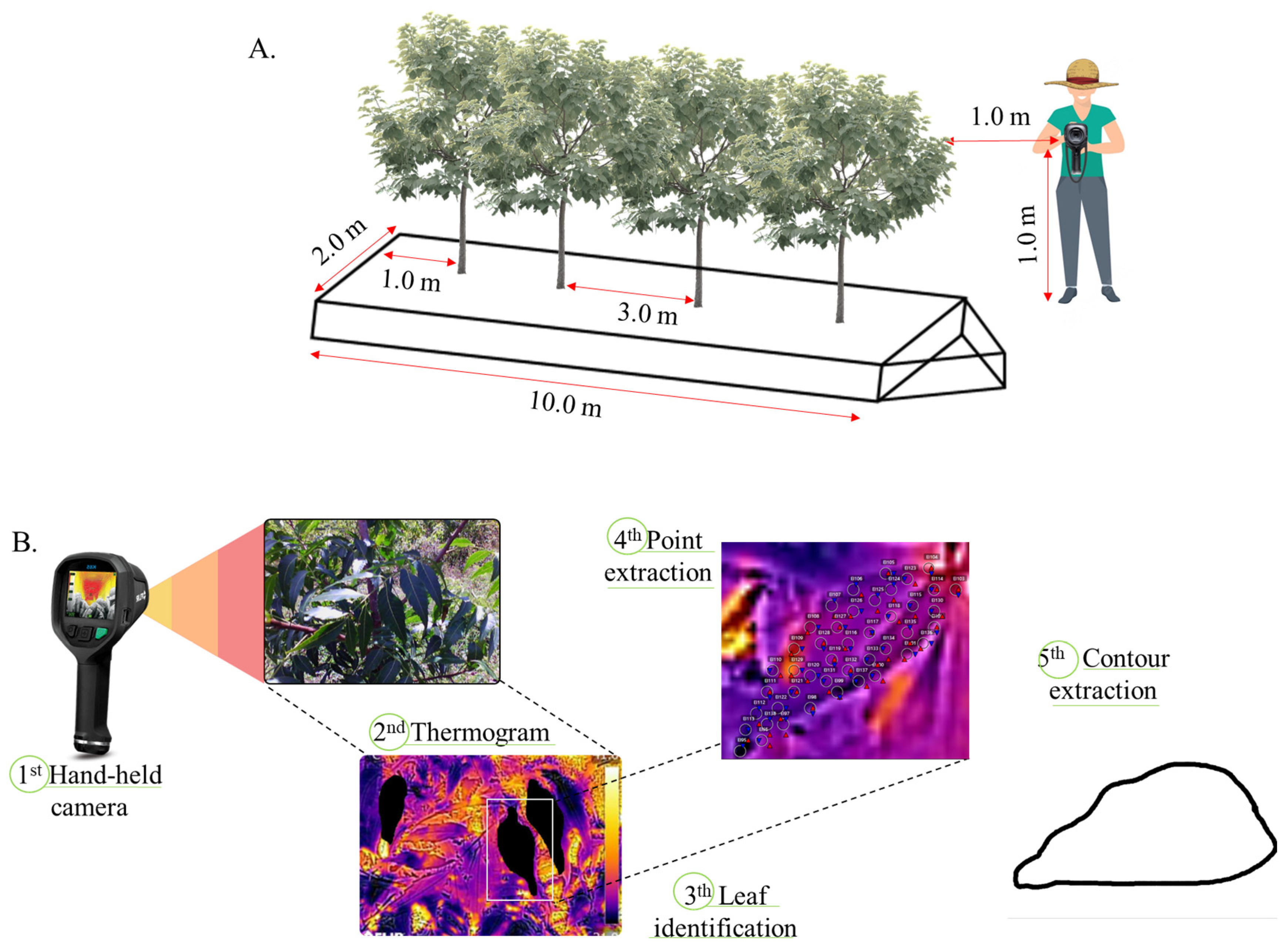
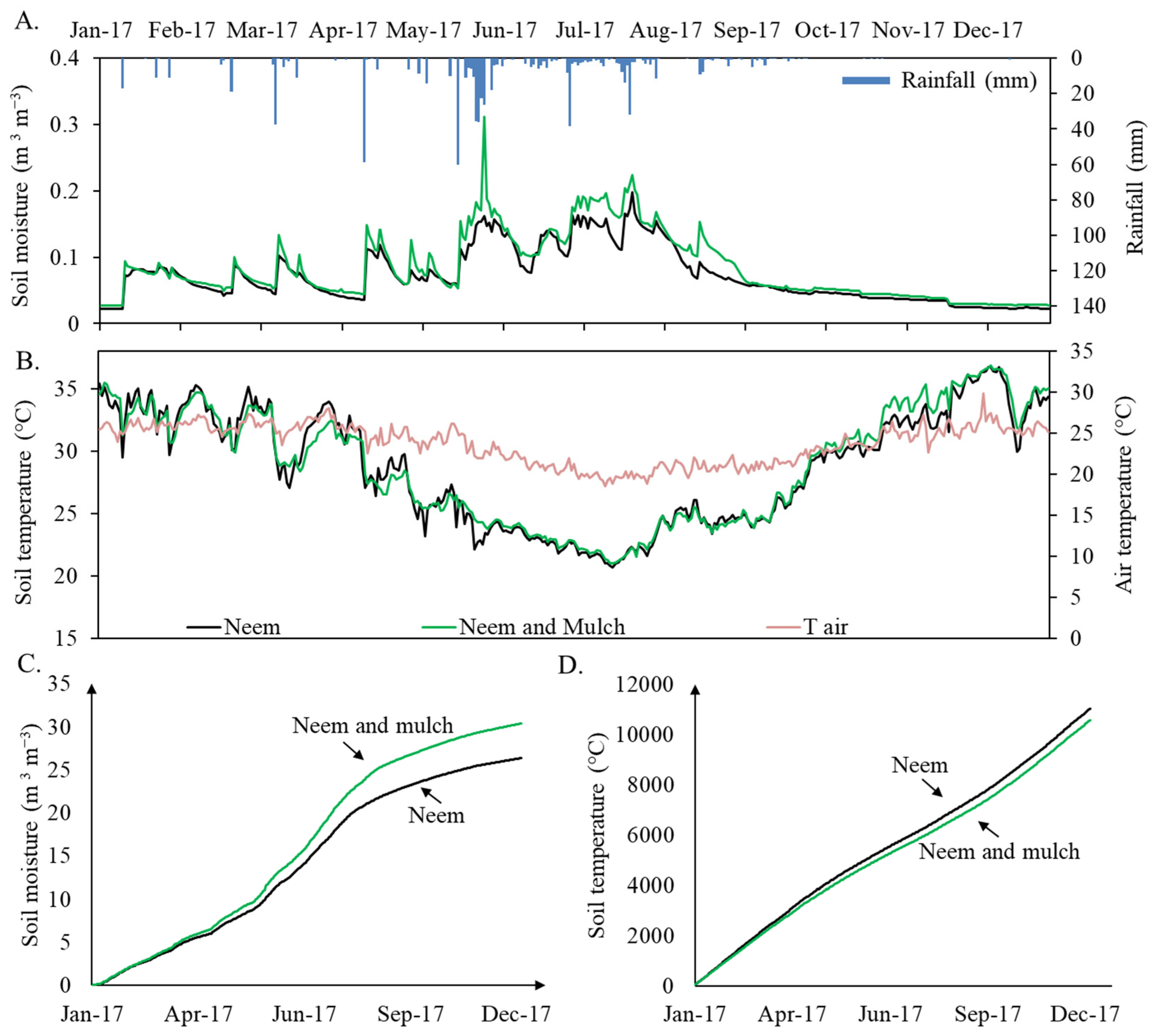
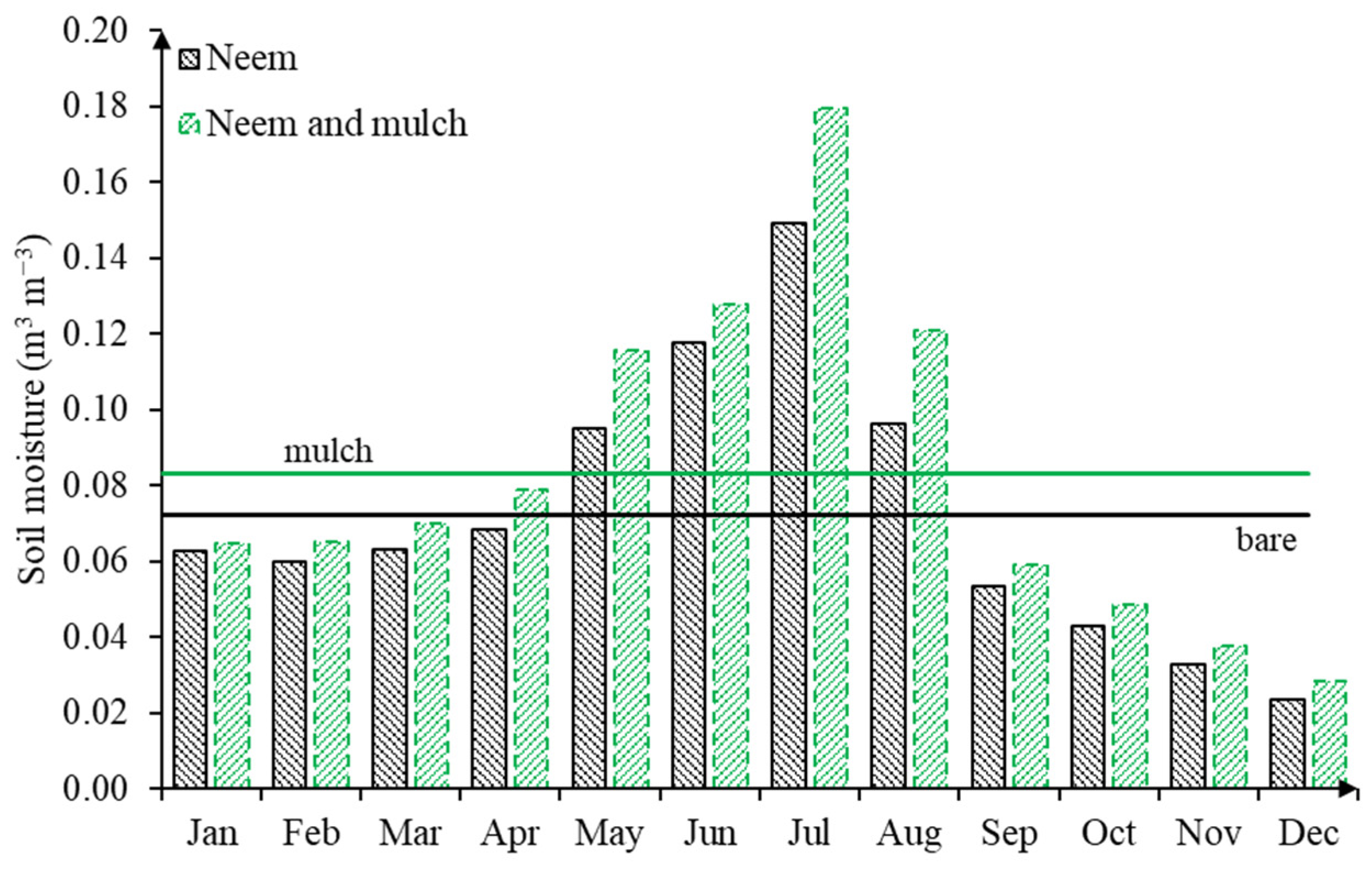
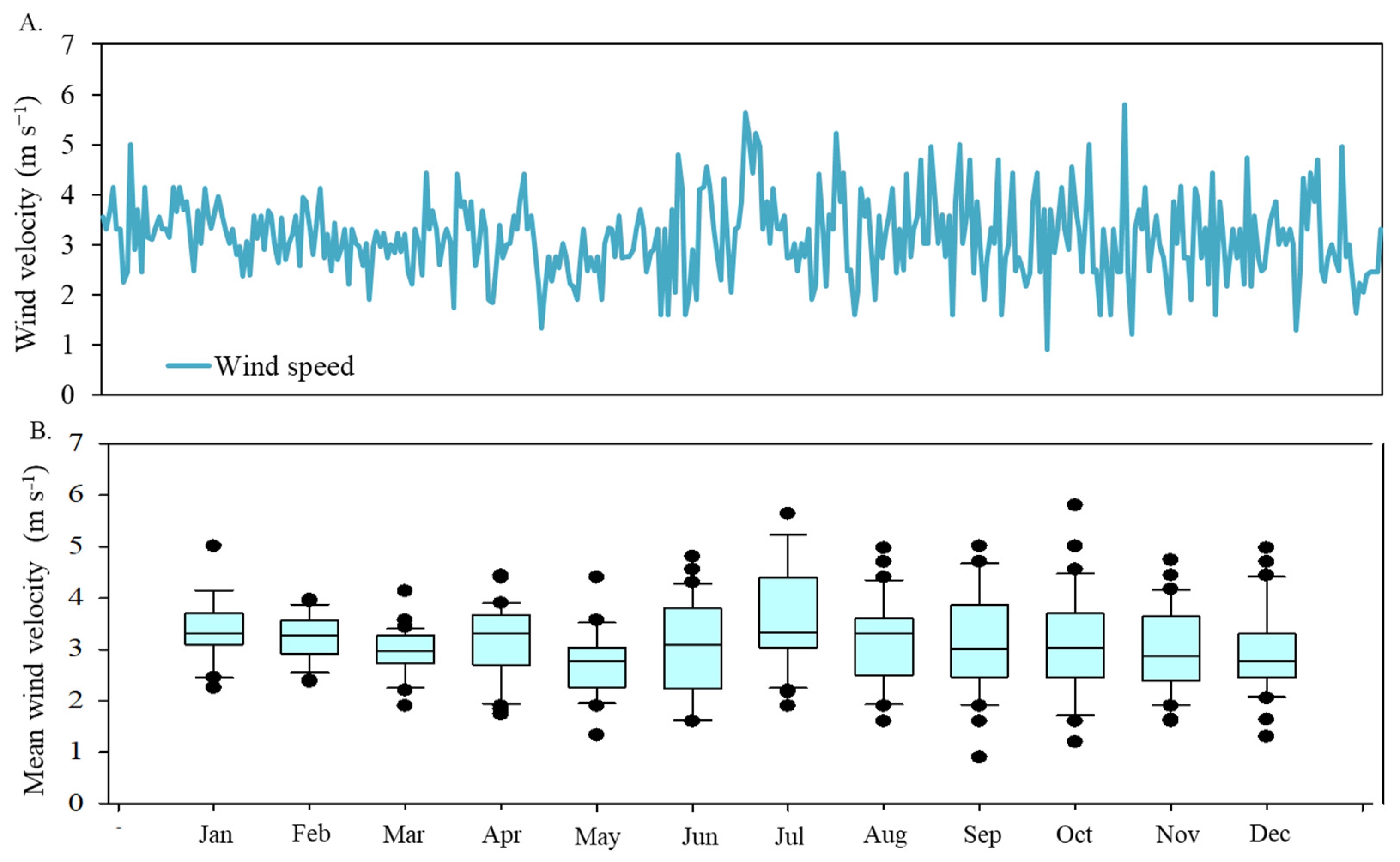
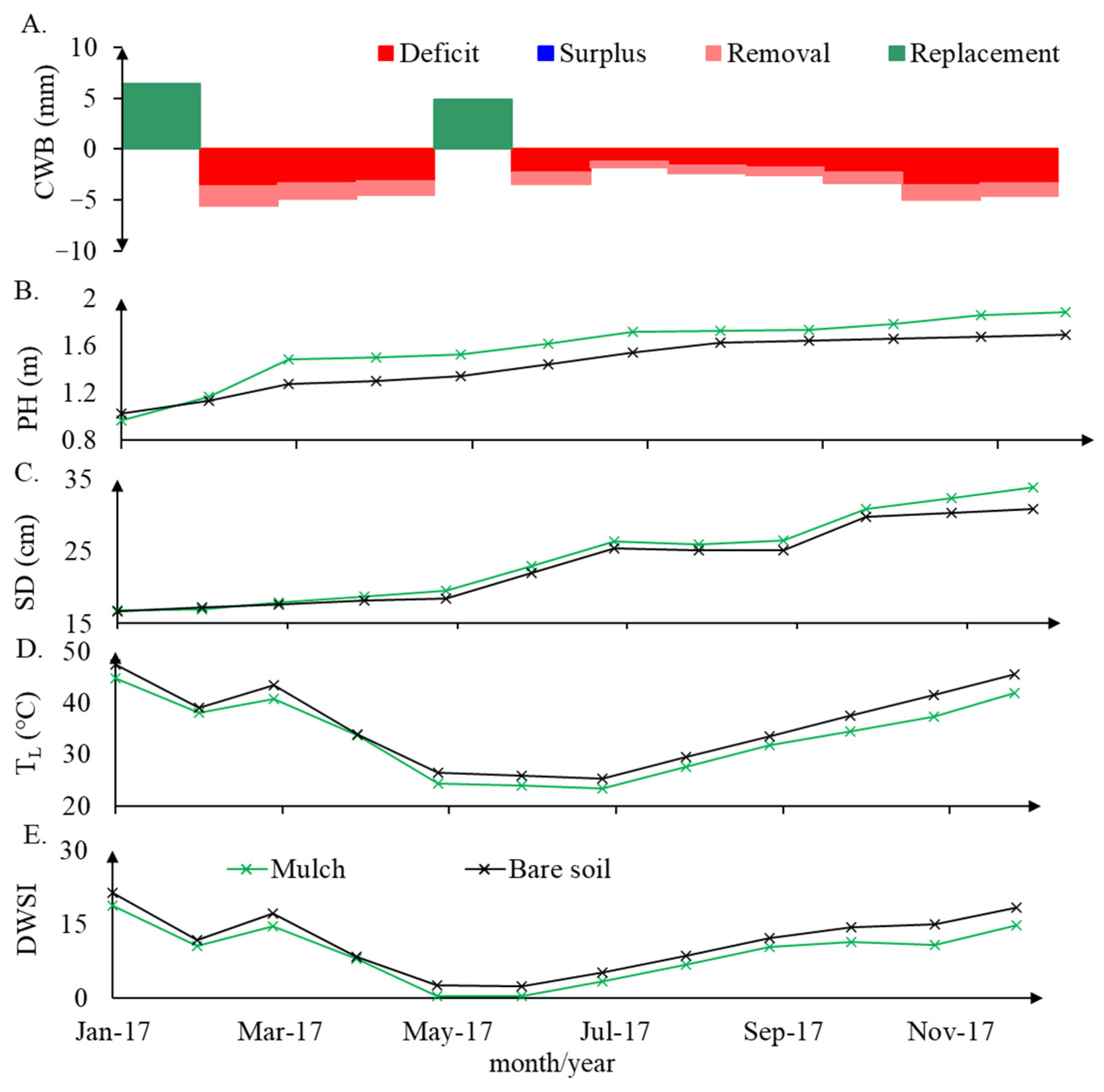
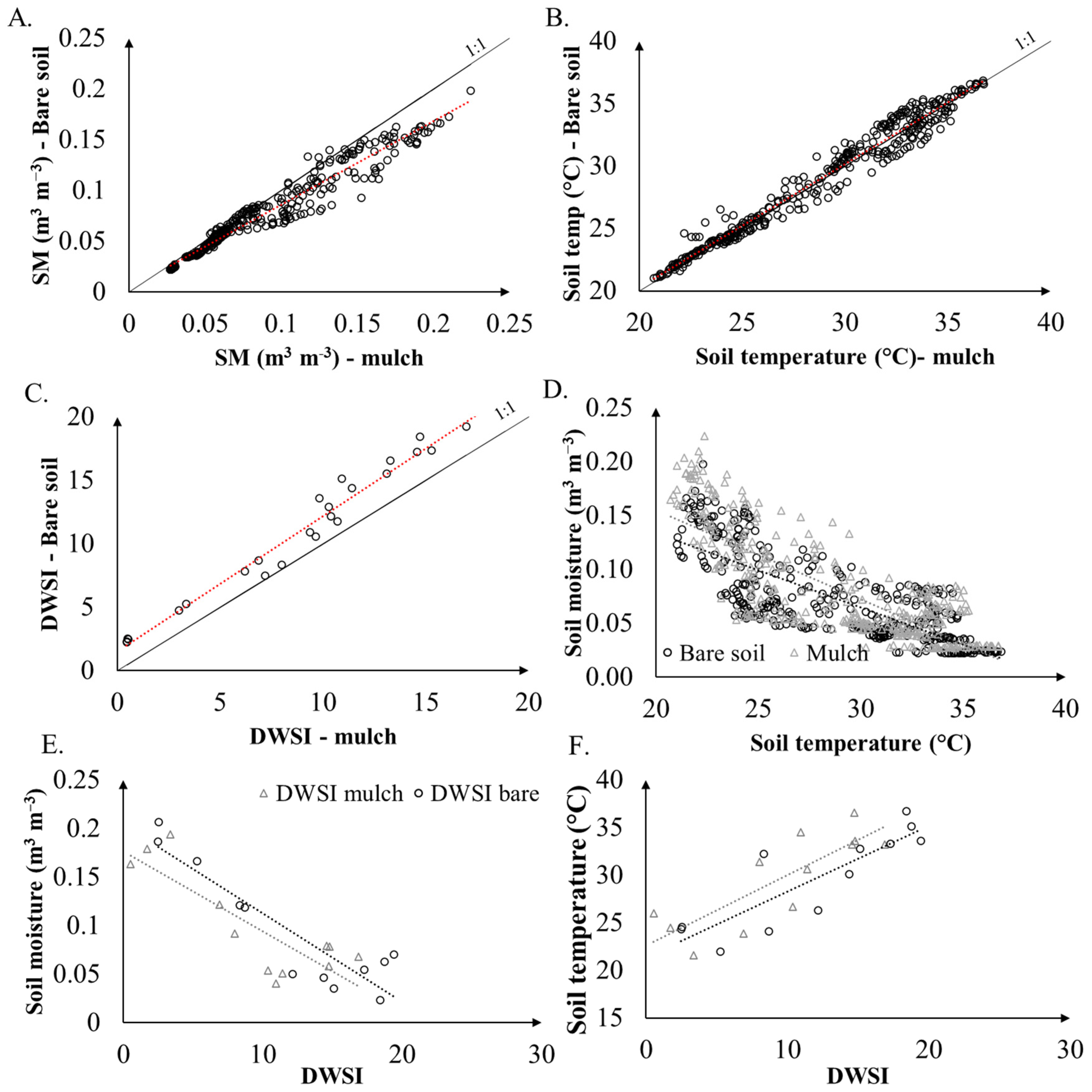


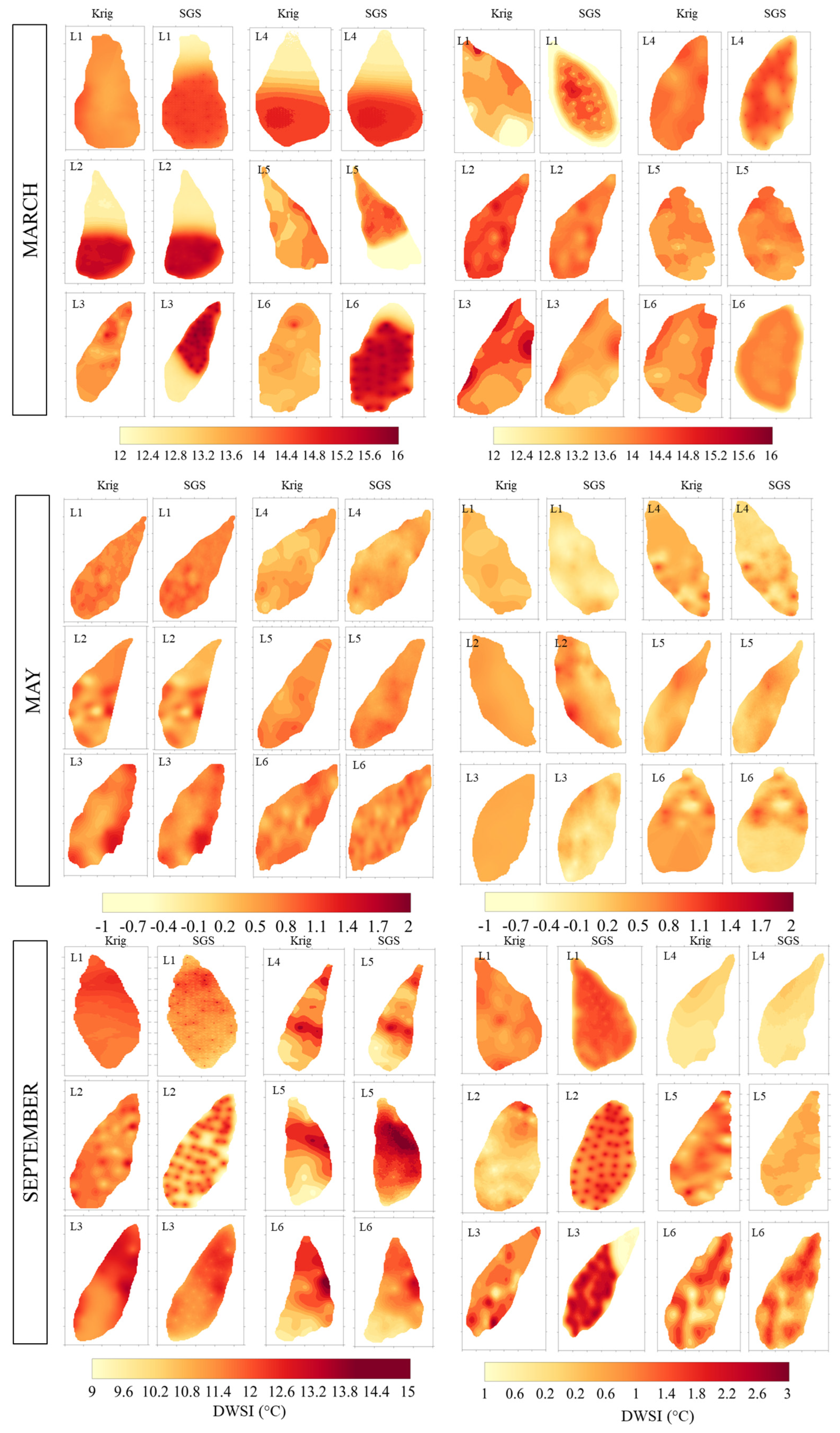


| Date | Cover | DR (mm) | R (mm) | ET0 (mm) | WS (m s−1) | TA (°C) | TL (°C) | DWSI (°C) |
|---|---|---|---|---|---|---|---|---|
| January (27 January 2017) | BS | 11.2 | 11.4 | 4.7 | 2.5 | 25.93 | 47.35 | 21.42a |
| M | 44.79 | 18.86a | ||||||
| February (27 February 2017) | BS | 0 | 23.8 | 5.6 | 3.9 | 27.33 | 39.08 | 11.75a |
| M | 38.04 | 10.71b | ||||||
| March (23 March 2017) | BS | 0 | 60.2 | 4.6 | 2.7 | 26.24 | 40.60 | 14.36a |
| M | 39.20 | 12.96a | ||||||
| April (24 April 2017) | BS | 2.6 | 72.6 | 4.6 | 3.4 | 25.62 | 33.97 | 8.35a |
| M | 33.62 | 8.00a | ||||||
| May (26 May 2017) | BS | 8.6 | 138.8 | 3.7 | 3.1 | 23.91 | 26.00 | 2.09a |
| M | 24.64 | 0.73b | ||||||
| June (22 June 2017) | BS | 0 | 30.0 | 3.7 | 4.5 | 23.42 | 25.94 | 2.48a |
| M | 23.90 | 0.52b | ||||||
| July (26 July 2017) | BS | 0.4 | 79.2 | 2.2 | 2.2 | 20.1 | 25.36 | 5.26a |
| M | 23.45 | 3.35b | ||||||
| August (25 August 2017) | BS | 0 | 20 | 2.46 | 4.9 | 20.7 | 29.41 | 8.71a |
| M | 27.58 | 6.88b | ||||||
| September (27 September 2017) | BS | 0 | 9.1 | 2.6 | 3.3 | 21.3 | 32.30 | 11.01a |
| M | 27.40 | 6.11b | ||||||
| October (26 October 2017) | BS | 0 | 0 | 3.3 | 3.0 | 23.1 | 37.48 | 14.38a |
| M | 34.51 | 11.41b | ||||||
| November (30 November 2017) | BS | 0 | 0 | 4.9 | 2.5 | 26.4 | 41.51 | 15.11a |
| M | 37.32 | 10.93b | ||||||
| December (22 December 2017) | BS | 0 | 0 | 4.7 | 2.6 | 27.12 | 45.55 | 18.43a |
| M | 41.86 | 14.74b |
| Month | CC | L | Mod | C0 | C0 + C | DSD | a | R2 | CC | L | Mod | C0 | C0 + C | DSD | a | R2 |
|---|---|---|---|---|---|---|---|---|---|---|---|---|---|---|---|---|
| MAR | BS | L1 | Gaus | 0.012 | 0.293 | 4.1 | 45 | 0.9 | BS | L4 | Gaus | 0.025 | 0.274 | 9.1 | 75 | 0.8 |
| L2 | Gaus | 0.083 | 0.311 | 26.7 | 43 | 0.9 | L5 | Gaus | 0.042 | 0.183 | 23.0 | 92 | 0.8 | |||
| L3 | Gaus | 0.075 | 0.328 | 22.9 | 75 | 1 | L6 | Gaus | 0.067 | 0.246 | 27.2 | 86 | 0.9 | |||
| M | L1 | Gaus | 0.038 | 0.182 | 20.9 | 62 | 0.9 | M | L4 | Gaus | 0.081 | 0.381 | 21.3 | 69 | 0.9 | |
| L2 | Gaus | 0.022 | 0.298 | 7.4 | 49 | 0.9 | L5 | Gaus | 0.039 | 0.141 | 27.7 | 78 | 0.8 | |||
| L3 | Gaus | 0.016 | 0.238 | 6.7 | 61 | 0.8 | L6 | Gaus | 0.032 | 0.298 | 10.7 | 63 | 0.8 | |||
| MAY | BS | L1 | Gaus | 0.070 | 0.297 | 23.6 | 55 | 0.9 | BS | L4 | Gaus | 0.022 | 0.282 | 7.8 | 74 | 0.9 |
| L2 | Gaus | 0.082 | 0.246 | 33.3 | 106 | 0.8 | L5 | Gaus | 0.018 | 0.131 | 13.7 | 133 | 0.9 | |||
| L3 | Gaus | 0.098 | 0.297 | 33.0 | 78 | 0.9 | L6 | Gaus | 0.011 | 0.139 | 7.9 | 62 | 0.9 | |||
| M | L1 | Gaus | 0.018 | 0.256 | 7.0 | 95 | 0.9 | M | L4 | Gaus | 0.012 | 0.528 | 2.3 | 96 | 0.8 | |
| L2 | Gaus | 0.065 | 0.286 | 22.7 | 77 | 0.8 | L5 | Gaus | 0.001 | 0.101 | 1.0 | 185 | 0.9 | |||
| L3 | Gaus | 0.028 | 0.188 | 14.9 | 43 | 0.8 | L6 | Gaus | 0.001 | 0.147 | 0.7 | 82 | 1.0 | |||
| SEP | BS | L1 | Gaus | 0.062 | 0.265 | 23.5 | 46 | 0.9 | BS | L4 | Gaus | 0.051 | 0.276 | 18.5 | 102 | 0.8 |
| L2 | Gaus | 0.061 | 0.208 | 29.3 | 89 | 1 | L5 | Gaus | 0.089 | 0.412 | 21.6 | 75 | 0.9 | |||
| L3 | Gaus | 0.066 | 0.263 | 25.1 | 52 | 1 | L6 | Gaus | 0.079 | 0.282 | 28.0 | 133 | 0.9 | |||
| M | L1 | Gaus | 0.046 | 0.361 | 12.7 | 79 | 0.8 | M | L4 | Gaus | 0.025 | 0.299 | 8.4 | 94 | 0.8 | |
| L2 | Gaus | 0.036 | 0.226 | 15.9 | 58 | 0.9 | L5 | Gaus | 0.01 | 0.231 | 4.3 | 115 | 0.9 | |||
| L3 | Gaus | 0.035 | 0.336 | 10.4 | 70 | 0.8 | L6 | Gaus | 0.013 | 0.151 | 8.6 | 91 | 1.0 |
| Plant/Method | Mean | SD | CV | ||
|---|---|---|---|---|---|
| March | BS | P1F Krig | 13.790 | 0.617 | 0.044 |
| P1F SGS | 13.783 | 0.626 | 0.043 | ||
| P2F Krig | 13.699 | 0.619 | 0.044 | ||
| P2F SGS | 13.762 | 0.646 | 0.046 | ||
| M | P1F Krig | 13.984 | 0.403 | 0.031 | |
| P1F SGS | 13.925 | 0.431 | 0.029 | ||
| P2F Krig | 14.046 | 0.321 | 0.023 | ||
| P2F SGS | 13.950 | 0.333 | 0.021 | ||
| May | BS | P1F Krig | 0.248 | 0.468 | 0.551 |
| P1F SGS | 0.262 | 0.476 | 0.529 | ||
| P2F Krig | 0.313 | 0.415 | 0.827 | ||
| P2F SGS | 0.311 | 0.439 | 0.746 | ||
| M | P1F Krig | 0.084 | 0.400 | 0.336 | |
| P1F SGS | 0.145 | 0.433 | 0.209 | ||
| P2F Krig | 0.310 | 0.344 | 0.330 | ||
| P2F SGS | 0.363 | 0.353 | 0.313 | ||
| September | BS | P1F Krig | 11.693 | 0.752 | 0.143 |
| P1F SGS | 11.642 | 0.809 | 0.125 | ||
| P2F Krig | 11.745 | 0.670 | 1.746 | ||
| P2F SGS | 11.756 | 0.513 | 1.363 | ||
| M | P1F Krig | 5.261 | 0.655 | 0.056 | |
| P1F SGS | 5.272 | 0.400 | 0.060 | ||
| P2F Krig | 0.384 | 0.372 | 0.061 | ||
| P2F SGS | 0.376 | 0.380 | 0.068 |
Disclaimer/Publisher’s Note: The statements, opinions and data contained in all publications are solely those of the individual author(s) and contributor(s) and not of MDPI and/or the editor(s). MDPI and/or the editor(s) disclaim responsibility for any injury to people or property resulting from any ideas, methods, instructions or products referred to in the content. |
© 2024 by the authors. Licensee MDPI, Basel, Switzerland. This article is an open access article distributed under the terms and conditions of the Creative Commons Attribution (CC BY) license (https://creativecommons.org/licenses/by/4.0/).
Share and Cite
Almeida, T.A.B.; Montenegro, A.A.A.; da Silva, R.A.B.; de Lima, J.L.M.P.; Carvalho, A.A.d.; da Silva, J.R.L. Evaluating Daily Water Stress Index (DWSI) Using Thermal Imaging of Neem Tree Canopies under Bare Soil and Mulching Conditions. Remote Sens. 2024, 16, 2782. https://doi.org/10.3390/rs16152782
Almeida TAB, Montenegro AAA, da Silva RAB, de Lima JLMP, Carvalho AAd, da Silva JRL. Evaluating Daily Water Stress Index (DWSI) Using Thermal Imaging of Neem Tree Canopies under Bare Soil and Mulching Conditions. Remote Sensing. 2024; 16(15):2782. https://doi.org/10.3390/rs16152782
Chicago/Turabian StyleAlmeida, Thayná A. B., Abelardo A. A. Montenegro, Rodes A. B. da Silva, João L. M. P. de Lima, Ailton A. de Carvalho, and José R. L. da Silva. 2024. "Evaluating Daily Water Stress Index (DWSI) Using Thermal Imaging of Neem Tree Canopies under Bare Soil and Mulching Conditions" Remote Sensing 16, no. 15: 2782. https://doi.org/10.3390/rs16152782







